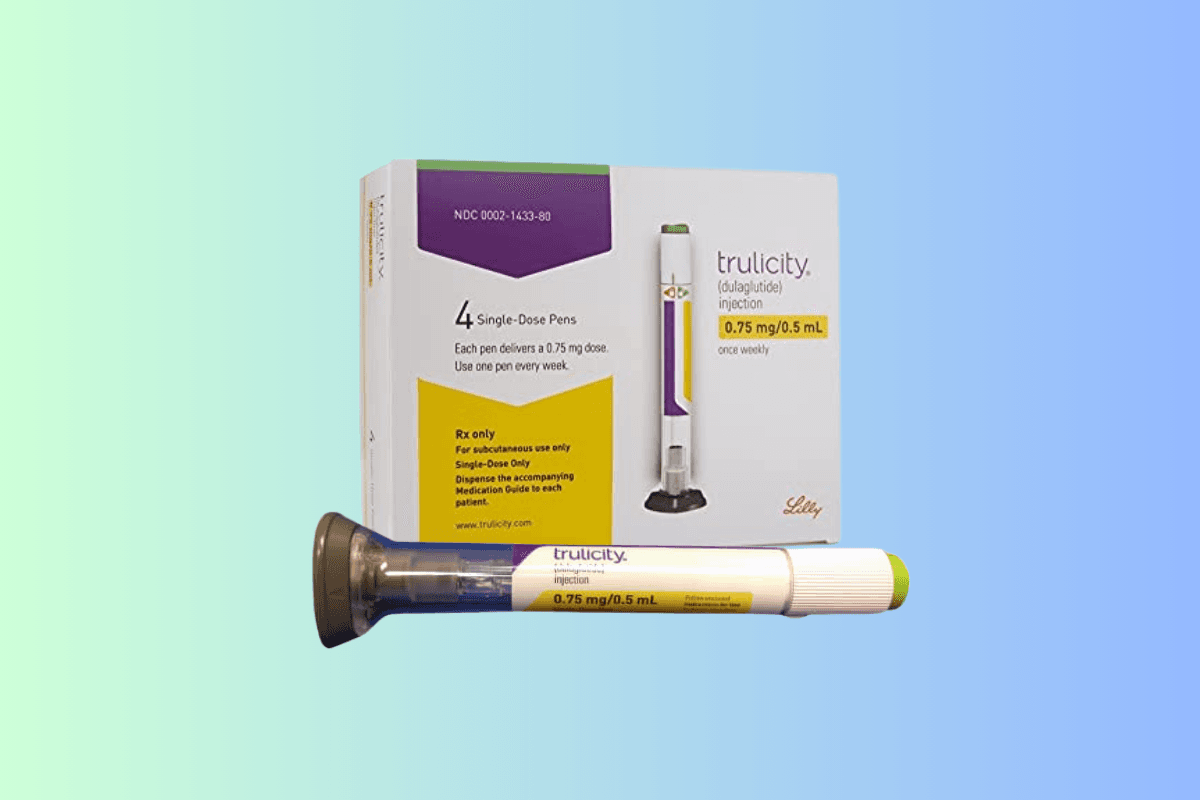Trulicity dosing follows a gradual, stepwise plan designed to balance benefits and tolerability. This overview explains weekly use, dose levels, and adjustment triggers. You will see how different strengths fit typical treatment goals, and where safety considerations matter. We also compare options and provide practical routines for consistent injections.
Key Takeaways
- Stepwise escalation: start low, increase slowly if tolerated.
- Weekly schedule: consistent day, flexible window if needed.
- Monitor regularly: glucose, A1C, weight, and side effects.
- Upper limits exist: stay within labeled maximum strength.
- Lifestyle support: eating patterns and activity improve outcomes.
Trulicity dosing: Core Schedule and Titration
Trulicity (dulaglutide) is a GLP-1 receptor agonist (gut hormone mimic). It is injected once weekly, using a prefilled, single-use pen. Most adults start at a lower strength and move up in measured steps. This staged titration helps reduce gastrointestinal adverse events (stomach and bowel side effects) while maintaining glycemic control. The weekly schedule supports routine, reducing daily decision fatigue.
Choose one consistent injection day. You may shift the day if necessary, as long as there are at least 72 hours between doses to avoid overlap. If a dose is missed, general guidance allows taking it within a certain window and then returning to the usual day. For labeled windows and formal precautions, consult the FDA prescribing information, which outlines timing and contraindications clearly (FDA prescribing information).
Starting, Strengths, and Devices
Prescribers usually recommend a trulicity starting dose that aims for tolerability. Lower strengths help patients adapt to GLP-1 effects on gastric emptying and appetite. Pens are single-use and color-coded by strength, simplifying weekly selection. Review your device’s instructions for use to understand cap removal, skin prep, and injection timing.
Here is a simple view of labeled strengths and their typical place in a step-up plan. Your prescriber may personalize steps based on response, tolerance, and concurrent medications. Do not change doses without clinical guidance.
| Strength | Typical Role | Notes |
|---|---|---|
| Lower Strength | Entry step | Used to establish tolerance before escalation. |
| Intermediate Strengths | Mid-course | Chosen when glucose or weight goals are unmet. |
| Higher Strengths | Ceiling | Reserved for persistent needs and good tolerability. |
For practical injection technique and comfort, our focused overview on Optimize Your Trulicity Dose explains site rotation and pacing, which helps reduce local irritation. If you want a concise roundup of labeled strengths, see Trulicity Dosage for a structured summary of the steps.
When and How to Increase Safely
Decisions about when to increase trulicity dose should weigh glycemic metrics, tolerability, and clinical goals. Many patients wait several weeks at each step to allow side effects to settle. If fasting or post-meal readings plateau above target despite adherence, clinicians may consider the next strength. Escalation should be avoided during active gastrointestinal symptoms.
When increasing, monitor changes in appetite, nausea, and hydration. Document glucose patterns and any hypoglycemia, especially if combined with insulin or secretagogues. Discuss your experiences with your care team before and after each adjustment. For a broader context on medication selection, our overview of Common Diabetes Medications can clarify how classes are combined thoughtfully.
Dose Ceilings and Plateaus
Your plan should define a trulicity max dose consistent with labeling and your risk profile. Moving to higher strengths may provide additional A1C or weight benefits for some, but not all patients will need or tolerate them. Dose-response curves often flatten, and pushing past tolerance may reduce adherence. The highest labeled strength is considered a ceiling, not a target for everyone.
When results plateau, revisit nutrition, activity, and other medications. Sleep, stress, and meal timing can meaningfully influence daily glucose swings. Where appropriate, your clinician may consider adjuncts like SGLT2 inhibitors. To compare GLP-1 options objectively, our analysis Trulicity vs Ozempic outlines similarities and differences that matter in practice.
Mid-Range Doses: 3 mg Considerations
A trulicity 3 mg dose may be proposed after lower steps show partial response. This intermediate strength can help bridge the gap between entry and upper levels. Patients sometimes report improved satiety, but gastrointestinal symptoms may transiently increase during the first weeks. Careful hydration and smaller, slower meals can ease the transition.
Side-effect profiles at mid-range doses are similar to lower levels but may occur more frequently during up-titration. If symptoms persist or worsen, remain at the current dose longer or discuss stepping back. Our article on Worst Side Effects of Trulicity provides practical strategies for managing nausea and diarrhea. Dietary adjustments are summarized in Foods To Avoid On Trulicity to reduce gastrointestinal load during titration.
Upper-Range Doses: 4.5 mg Snapshot
An upper-range trulicity 4.5 mg dose is reserved for patients who tolerate intermediate strengths and have ongoing clinical needs. It may offer incremental A1C or weight benefits in select cases, though individual response varies. Before advancing, evaluate side-effect stability, renal status, and concomitant therapies. Higher doses should remain within labeled boundaries and monitored closely.
Supplies can fluctuate. If a preferred strength becomes temporarily unavailable, clinicians may hold the current dose or use an alternative based on risk–benefit. For users comparing upper-range GLP-1 options, explore Trulicity vs Mounjaro for perspective on efficacy and tolerability. Those considering non-GLP-1 choices can review Dapagliflozin as an SGLT2 option when combination therapy makes sense.
Practical Use: Weekly Rhythm, Missed Doses, and Storage
Maintain a routine that supports trulicity dosage weekly administration. Set calendar reminders and pair the dose with a consistent activity. If you miss a dose, labeled guidance allows a defined catch-up window; then return to your usual day. Avoid doubling doses, and keep at least 72 hours between injections to prevent stacking.
Store pens as directed in the manufacturer’s instructions, protecting from extreme temperatures. Inspect the device before use and rotate injection sites across abdomen, thigh, or upper arm. If you are exploring alternatives for oral incretin therapy, Rybelsus Semaglutide Pills provide a non-injectable option in select scenarios. For readers broadening their GLP-1 knowledge, our guide to Trulicity Uses explains indications and expected outcomes.
Weight, A1C, and Real-World Expectations
GLP-1 receptor agonists can help lower A1C and support weight reduction, but results vary. Average changes seen in trials may not reflect individual biology, dietary patterns, or comorbidities. Emphasize sustainable habits: protein-forward meals, non-starchy vegetables, and gradual activity increases. Consider resistance training, which can improve insulin sensitivity and preserve lean mass.
Track metrics that matter to you. Many patients monitor fasting glucose, postprandial readings, waist circumference, and energy levels. Set realistic timelines and expect variability week to week. Contemporary guidelines summarize personalized goals and safety considerations; the ADA Standards of Care provide a useful framework for clinicians and patients.
Comparisons and Alternatives
Some patients compare agents within the GLP-1 class or across classes to match priorities. Formulations differ by molecule, dose range, and delivery device. Tolerability and effect size also vary by person. A side-by-side view can clarify trade-offs across glycemic control, weight outcomes, and dosing convenience.
For detailed contrasts, see our editorial comparisons: Trulicity vs Saxenda discusses weight-focused choices, while Byetta vs Bydureon covers exenatide formats and dosing realities. If you are evaluating broader therapy strategy, explore Mounjaro Dosage Guide for a different incretin pathway. Readers tracking program costs can review Trulicity Savings Card to understand common affordability options.
Safety Signals and Side Effects
Common side effects include nausea, vomiting, diarrhea, and decreased appetite. These usually appear during titration and often ease over time. Eat slowly, reduce portion sizes, and avoid large, high-fat meals during dose changes. Seek prompt care for severe, persistent, or unusual symptoms such as significant abdominal pain or dehydration.
Important safety information, including contraindications, boxed warnings, and pancreatitis risk, is detailed in official labeling. For complete safety statements and contraindications, review the FDA prescribing information before any changes. For day-to-day mitigation strategies, our piece on Foods To Avoid On Trulicity explains gentle meal choices that may reduce nausea.
Note: Discuss any history of pancreatitis, gallbladder disease, or severe gastrointestinal disorders with your clinician before adjustments. Tell your clinician about all medicines, including insulin or sulfonylureas, as combinations may increase hypoglycemia risk.
Recap
This guide outlined a structured, weekly plan that prioritizes tolerance and steady progress. You learned how to set starting strengths, when escalation may be considered, and where upper limits apply. We also discussed practical routines, safety points, and fair expectations for outcomes. Use these concepts to inform shared decisions with your care team.
For deeper dives on dose strategy and side effects, revisit Optimize Your Trulicity Dose for practical tactics and Worst Side Effects of Trulicity for safety planning.
This content is for informational purposes only and is not a substitute for professional medical advice.


